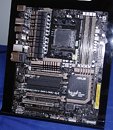Wednesday, January 9th 2013

ASUS Unveils World's First PCI-Express 3.0 Motherboard for AMD Processors
ASUS did the unthinkable yet simple, by innovating the first AMD platform motherboard that features PCI-Express 3.0 x16 slots, the Sabertooth 990FX/GEN3.0 R2.0. Long naming aside, the board provides you a couple of gen 3.0 slots by using PLX-made 48-lane PCI-Express Gen 3.0 bridge chip.
While the board features four PCI-Express x16 slots, only two similarly-colored slots can be used at a time, of which two are PCI-Express 2.0 x16, wired to the 990FX northbridge, and two slots being x16/NC or x8/x8-capable, being wired to a PLX 48-lane PCI-Express Gen 3.0 switch, which in turn takes two PCI-Express 2.0 x16 links from the northbridge.Apart from this unique feature the socket AM3+ Sabertooth 990FX/GEN3.0 R2.0 features AMD SB950 southbridge, eight SATA 6 Gb/s ports, two eSATA 6 Gb/s, 8-channel HD audio, six USB 3.0 ports, and a zesty ASUS-exclusive feature-set. The new board could be released to the market very soon.
While the board features four PCI-Express x16 slots, only two similarly-colored slots can be used at a time, of which two are PCI-Express 2.0 x16, wired to the 990FX northbridge, and two slots being x16/NC or x8/x8-capable, being wired to a PLX 48-lane PCI-Express Gen 3.0 switch, which in turn takes two PCI-Express 2.0 x16 links from the northbridge.Apart from this unique feature the socket AM3+ Sabertooth 990FX/GEN3.0 R2.0 features AMD SB950 southbridge, eight SATA 6 Gb/s ports, two eSATA 6 Gb/s, 8-channel HD audio, six USB 3.0 ports, and a zesty ASUS-exclusive feature-set. The new board could be released to the market very soon.

43 Comments on ASUS Unveils World's First PCI-Express 3.0 Motherboard for AMD Processors
That's the weirdness that gets me. I understand all the stuff about switches.
What made sense to me si that PCIe 3.0 encoding was used, but like you say, SB shouldn't be able. Yet...
I mean, we can generally say, that if IVB is used, no matter the board, PCIe 3.0 is possible, link width is questionable though, and dependant on switches used. No problem there, of course, very straight forward.
Using PLX PEX8747, on PCIe 2.0, giving PCIe 3.0, does add some boost to multi-GPU, even though to the CPU is still just PCIe 2.0. So this ASUS board, to me, makes sense for multi GPU users.
Those PCIe 3.0 cards on this board, they'll show up as PCIe 3.0, I am almost willing to bet.
Are they really running 3.0? I guess the PLX PEX8747 makes this possible...or does it?
:roll: products like this one don't make this any easier. :roll:
I can see there is some sort of argument here. Put simply a normal Z68 or Z77 won't run Gen 3 without a Ivybridge CPU, that is simply fact. There is only one motherboard which is an exception to this rule and it is a ECS Z77H2-AX which has an additional chipset which allows Gen 3 with the use of a Sandybridge CPU; however, the motherboard in question is expensive and hard to get and you are looking to pay around £280 for it on ebay. There is a review of this particular motherboard on here for that.
Also to add, yes this particular ECS motherboard does make use of a PLX PEX8487 chipset.
Here is the review I mentioned: www.techpowerup.com/reviews/ECS/Z77H2-AX_review/13.html
There are other Z77 motherboards with the PLX PEX8487 chipset
The current Sabertooth 990FX is around $180. Due to the PCIe switch, the new model is going to cost more and it's questionable at this point if there will be anything gained by it's use. Shelling out less for a better performing Ivy Bridge system is looking really good right now.
I noticed a MSI hardware guy on here and had a question similar to this discussion. I've been looking at a device that will (passively) switch a single x16 slot to two x8 slots using a flexible cable and a PCB with two x16 slots on it. It requires support for pci-e bifurcation but doesn't explain if thats a chipset, MB, or CPU feature or if it requires the BIOS to allow it (or if it just automatically splits the first port into whatever the other two ports need).
Any ideas? It would make it possible to turn my mATX board into something with a bit more expansion possibilities with lower bandwidth cards (stuff thats plenty happy with a couple lanes or less).
ark.intel.com/compare/63696,70845
I don't know, I'm not going to bother with benchmarks I'll be back with more information with Ivy Bridge being PCI-E 2.0. Ivy Bridge and Sandy Bridge-E have the same thing they have PCI-E 2.0 that can run at 8 GB/s. Sandy Bridge-E has 40 lanes of PCI-E 2.0(@3.0 Speed) while Ivy Bridge has 16 lanes of PCI-E 2.0(@3.0 Speed) going through one PLX switch or several PLX switches. (variations: 16x/16x/16x or 8x/8x/8x)
True native PCI-E 3.0 won't be supported till Haswell, hopefully. PCI-E 3.0 isn't just speed.
The next generation is either Socket GC36 or this unknown socket which is based on Socket F and Socket G3.
I've only seen the APU one and the server one.
28-nm FMx = Bolton <-- Socket (Mainstream)
28-nm LGA1 = Riverside <-- Socket (Performance)
28-nm LGA2 = Riverside <-- Socket GC36 (Server)
^(Only the FMx socket is compatible with the previous chipset since the infrastructure for LGA1/2 is substantially different than Socket C32/G34 and AM3+)
Server side still shows a split 2P and 4P side through 2015 along with AM3+ through mid 2014.
Like I said beforeThey also mention AMD moving to a unified socket after FM2+ and AM3+ run there course.
source